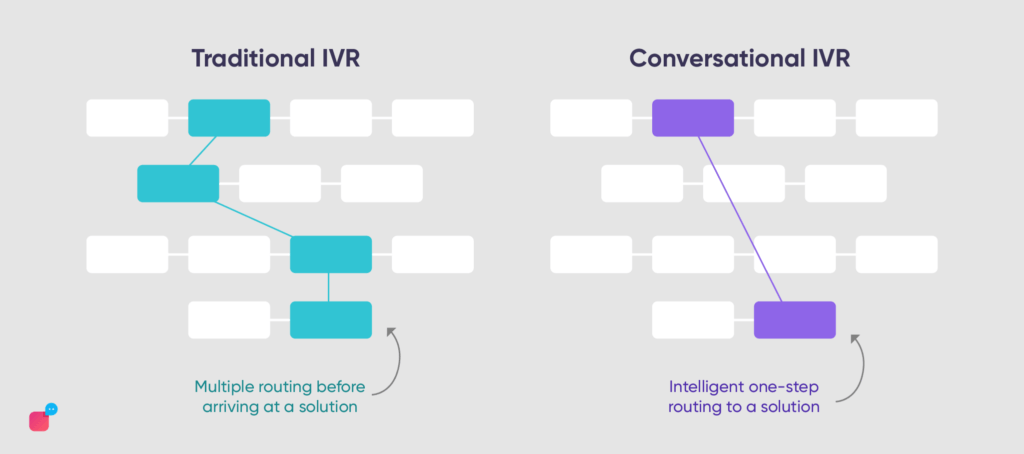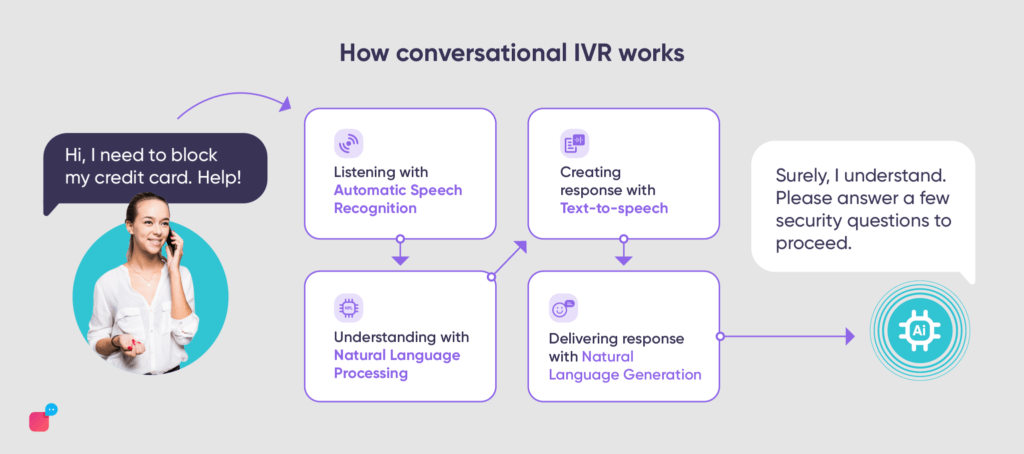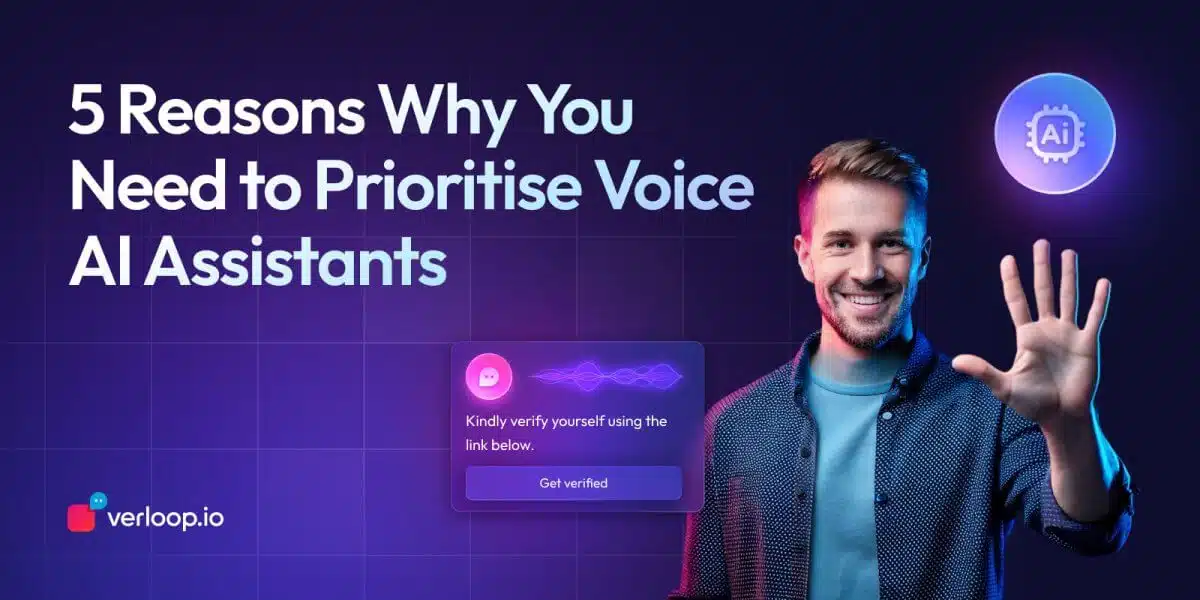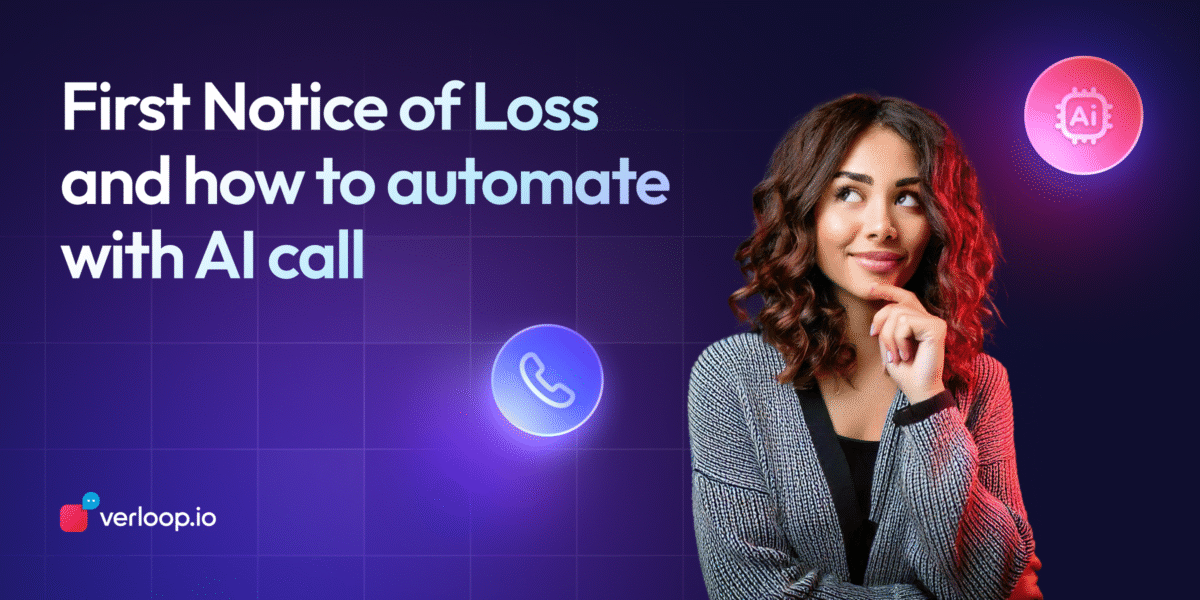
Automated IVR Calls: Upgrade Your IVR Set-up with conversational AI
- April 22nd, 2025 / 6 Mins read
- Harshitha Raja
Technology has transformed customer support and service with AI and Interactive Voice Response (IVR) systems at the forefront of it. These tech infrastructures let callers derive information from an automated system with a set menu. While IVR works best as a data giver, the limited scope of interaction has pushed many businesses to switch to a more conversational tool
This often sparks comparisons such as IVR vs. Conversational AI, whereas the need of the hour is to combine the two to improve the service quality of call centres, client-focused businesses and notification systems.
In this blog, we’ll explore how automated IVR calls are evolving in 2025. Let’s explore everything from “what is IVR” to how you can harness the various advancement in IVR service for better customer experiences.
Table of Content:
- What is IVR?
- Where and how can IVR service be used?
- What are the challenges faced by traditional IVR?
- What are the use cases of smart IVR with conversational AI?
- Why upgrade your IVR service with conversational AI?
What is IVR?
IVR, or interactive voice response, is a telephonic feature that interacts with callers and directs users to information by offering them options from a menu. Following that, it takes appropriate action based on the caller’s voice or keypad responses.
In simple terms, if you’re wondering what is an IVR call, a conventional IVR service provider associates certain actions with different numbers on the keypad and plays a pre-recorded message telling the user the relevant information. It then processes specific number taps on the phone screen to come up with the next steps.
Over the past few years, it has revolutionised client-company relationships by providing an automated interface that’s active 24/7 – especially instilling modern functionality to call centres.
Where and how can IVR service be used?
There are plenty of ways to use IVR systems to enhance marketing and sales, boost client loyalty, improve agent productivity, and reduce costs if you work for a company where clients often call you. Some popular interactive voice response examples are as follows:
- Relevant skimming down and redirection of callers in call centres to topic experts without wasting hours on their cell phones
- Answering entry-level FAQs without any employee intervention
- Helping callers avail agent support in the language of their preference and reducing friction
- Carrying out low-cost marketing campaigns via telephonic exchanges using an existing database,
Earlier, conventional IVR service seemed to work just fine for businesses, since customer expectations were lower and the scope of automation was limited. However, today the times are quite different. Traditional IVR service now poses a number of drawbacks that limit businesses from achieving higher efficiency and economies of scale.
Challenges faced by the traditional IVR Setup
Traditional IVR calls doesn’t seem to make the cut with high digital competition and more advanced automation at our disposal. Let’s take a look at some of the IVR challenges.
1. Lack of personalisation
Convenience and customisation are roadblocks to augmented modern user experiences. However, an IVR service is unable to answer questions that are not on a list of 5-6 pre-determined queries and cannot cater to unique customer needs. Thus, they redirect calls largely based on umbrella terms, reducing the accuracy and efficiency of the linked IVR call centre.
2. Overly mechanised exchange
One thing that puts people off of IVR is its overly robotic exchange methods. This makes for a subpar user experience and leads to people seeking help from company officials no matter how big or small their issues are. However, automated IVR built with voice recognition could help more people self-serve in a bidirectional interactive set-up.
3. Lengthy resolution process
The point of automation is to reduce customer waiting time, but IVR calls can sometimes be counterproductive. Callers have to wait around and hear lengthy telephonic instructions and go through various rounds of key tapping to either arrive at another monologue.

4. Confusing and irrelevant options
In an IVR call, the system narrates a plethora of options in a speedy manner. Listening through all of them and understanding their application to pick an option that best fits the user can become tiring. This leads to frustration as they have to listen through confusing listicles that may not even be useful for them.
The way forward: Use cases of automated IVR calls
Despite all the merits of an IVR service, an AI disruption is much needed for call centres to level up their voice terminal for users.
IVR and conversational voice AI, when blended, use the strengths of NLP and ML to produce interactions that are convincingly human-like and efficient. The speech-to-text and AI voice recognition feature lets clients express their concerns directly without scourging through options.

It helps companies collect client data better and humanises customer support like never before.
1. Lead generation
Making IVR or interactive voice response, the asset in their calls to action is an intriguing way sales reps can utilise the technology. For instance, when users call company helplines, the IVR can collect data regarding their preferences, current products owned by them and their potential needs. This way reps will have more info going into the sales call and be able to prioritise leads based on chances of conversion.
2. FAQ resolution
FAQs are primarily responsible for the high volume of calls – one of the biggest challenges in contact centres. IVR systems with voice AI answer these queries quickly and over a wide range of topics, bringing in only pertinent and offbeat questions to the human agents.
3. Feedback collection
Conversational Voice AI-powered IVR helps companies retain customers and better their operations by receiving feedback via calls. This lets them carry out regular assessments without dedicating too much manpower, all the while building brand loyalty.
4. Updates and reminders
Companies can provide updates regarding upcoming deliveries, transactions, events, bookings and more using Conversational Voice AI-supported IVR calls. They can send targeted reminders to ensure timely action. This helps them keep a large audience in the loop without building an entire team to execute the job.
5. Client database building
Voice AI-backed IVR can be used by companies to build client databases via telephonic surveys pre-and post-sales. This can help businesses gain insights regarding future product launches and build a database of one-time/ returning customers. This collated data can help businesses predict future user demands and behavioural curls well in advance,
Advantages of Voice AI-enhanced automated IVR calls
If higher engagement and more interactive latitude weren’t the apparent reasons why voice AI-enhanced automated IVR calls were your best bet, here are a few more!
1. Greater customer satisfaction
IVR with voice AI capabilities cuts waiting times and enables users to independently find the answers to frequent queries, resulting in more fruitful interactions. When supplemented with engaging voice tech built on powerful ASR, it lets clients feel more understood with less toiling. With quicker resolutions and fewer menu hops, your customers are more likely to drop the call delighted!
2. Increased agent efficiency
Clients that use Conversational Voice AI-powered IVR calls can receive answers to their questions right away. This improves the effectiveness of the customer care system and lessens the workload on your team, which lets agents dedicate their productive time to where it’s essentially needed. Monotonous work is frustrating, and bored (yet overworked!) agents look for more cerebral stimulation. Conversational IVR helps your agents redirect their energy to areas of improvement that need the most attention.
3. Reduced operational costs
The cost of providing customer service 24×7 can be reduced drastically by using different types of IVR (inbound and outbound) powered by conversational voice AI technology. With the help of these technologies, fewer calls will need to be handled by live agents, and fewer callbacks, repeat calls, and escalations will occur. And so, it results in better workforce allocation and significantly reduced costs.
Automated IVR Calls: the next-gen interactive voice response system
For call centres and B2C businesses, voice Al-backed IVR benefits are never-ending. The technology helps you stay ahead of the curve while straightening out all communication channels.
Verloop.io’s Voice AI helps businesses champion customer support with its cost-effective, technically superior, and reliable automated IVR solutions built using state-of-art conversational AI. So if you’re ready to level up your firm, Verloop.io is the way to go.
Schedule A Demo
FAQs
What is an IVR call?
An IVR call refers to a phone interaction managed by an Interactive Voice Response or IVR service, where the caller navigates through automated menu options using voice commands or keypad input.
What is the full form of IVR call?
The IVR call full form is Interactive Voice Response call. It refers to the process of handling customer inquiries using automated voice technology without a live agent.
How do voice AI calls improve automated IVR systems?
Voice AI calls enhance traditional IVR systems by adding conversational capabilities. Instead of rigid keypad-based navigation, voice AI allows callers to speak naturally, making the experience more intuitive and faster. In 2025, combining voice AI with IVR helps businesses deliver smarter, more personalised support while reducing operational costs and agent workload. This integration is key to transforming automated IVR calls into dynamic, customer-friendly interactions.






